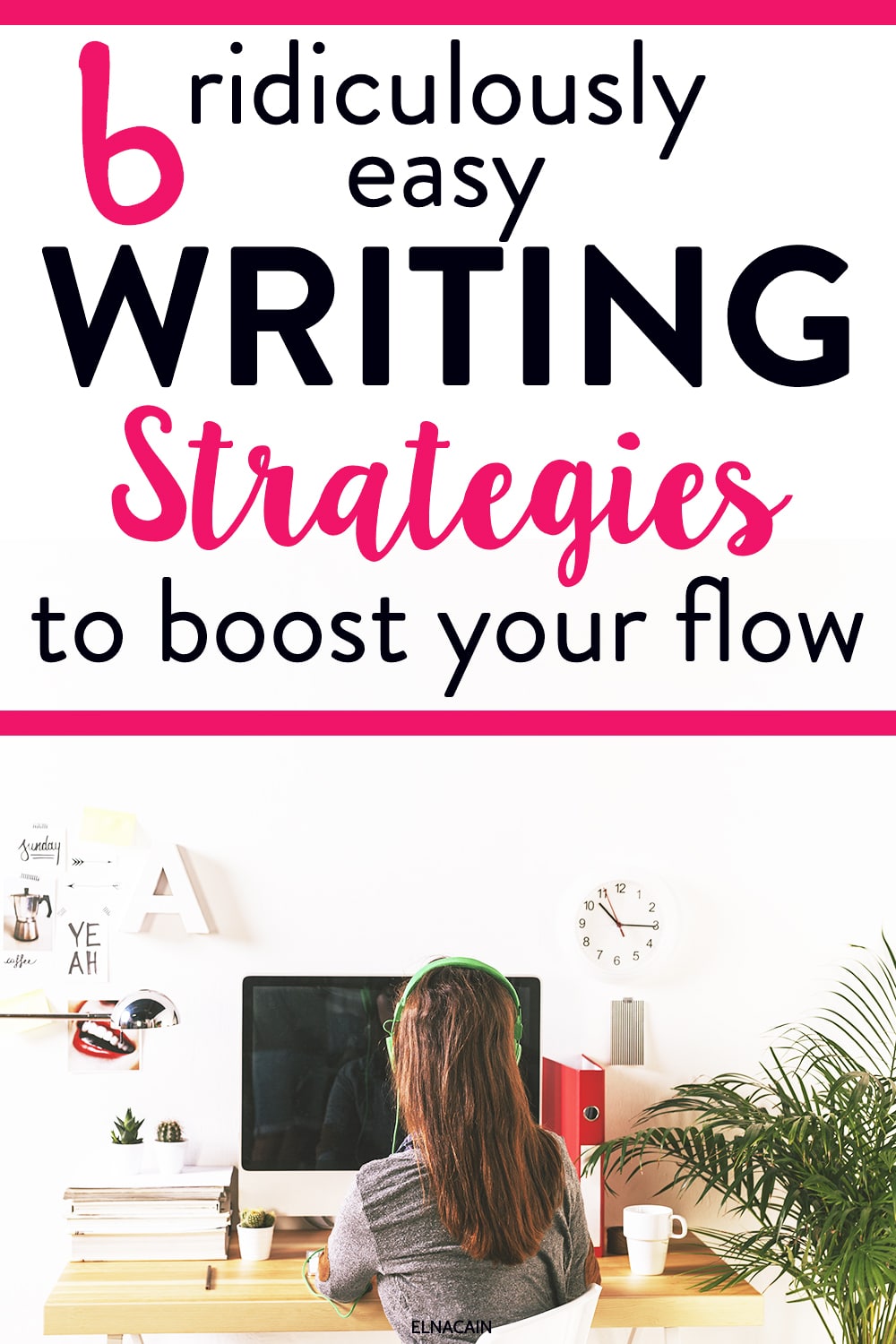As a freelance writer, the one thing I pride in myself is the ability to write fast.
I can quickly access my zone of genius and turn off all distractions and write. This is my writing flow and when I’m accessing my flow, I can whip out blog post after blog post and write 3,000 or 5,000 words in a few hours.
But, this didn’t happen over night.

I had to hone my writing flow so that I’m more productive. I used writing strategies to find my flow quickly and stay there for as long as possible.
The flow I am talking about is that moment where the words just flow and time passes without you even noticing.
Do you want that?
Here are the writing strategies to help you get in the flow and boost your writing productivity if you are new to writing.
By finding your writer’s flow, it will help you write more in less time.
6 Writing Strategies

1. Find Your Sacred Writing Space
Chris Fox first brought to my attention the idea of having a sacred space for writing.
This spot can be anywhere, but you don’t do anything else in this spot.
For example, don’t try to write on the couch with your laptop if you often check social media or email there. Pick the one spot that is just for writing and train yourself to spend time in that spot each day just writing.
It will take a few days for your brain to make the connection.
I am not an expert on the inner workings of the brain, but I do have firsthand experience at training myself to get into the writing flow quicker by having a sacred writing spot.
When I go to my office, my brain knows that it is time to get to work as soon as I sit down and open up a word document. I am not tempted to check my social media accounts or favorite shopping sites because I don’t allow myself to do that in these spots.
The first handful of times that I tried to work in my office without checking my email or social media profiles, I couldn’t get anything done. But, I kept training myself to focus when I write, and now, I can go in, sit down in my usual spot and crank out work.
2. Find Your Peak Productivity Time

If you don’t already know, most people have peak productivity hours. Everyone will be different, but it is important to find yours.
I always thought mine were 11 p.m. to 2 a.m. but turns out I am not a night owl after all. I discovered my peak productivity hours were 9:30-12:00, so that is the time I make sure to remove distractions and write.
How do you find your peak productivity time?
Try tracking your word count and workflow at different times of the day. This is easier if you are able to work full-time, but if you are like me and work at home and take care of small children full-time, it will take more time to find your sweet spot.
Start with nap times, bed time, and waking up an hour or two before the children. How productive are you at those times?
Next, try to hire a babysitter or ask a family member to watch your children during the morning hours and afternoon hours. Did you find that you were able to knock out more work in one of those time frames?
3. Try Dictation Software
I wasn’t sure if I was going like the idea of dictation, especially since I am so used to having the ideas flow from my mind straight to my fingertips while I type.
However, the new pains from carpal tunnel and eyestrain were showing me that I needed to give it another shot.
I then saw another successful author post that he had to make the switch to dictation once his disability took away the use of his hands. He said he could not get the right flow going at first, and I can definitely relate.
When you first start using dictation the words will feel choppy, and you won’t be sure which word you are going to say next.
You have to learn how to sync your brain with your mouth. I can easily tell someone how to do something, and I can adequately write a how-to article, but dictating that same article is still taking practice.
It is going to take a lot of practice until you can successfully get your flow of words going, while also figuring out the right commands to make your words appear grammatically correct.
For example, to say the sentence, “My dog, Robert, is a good dog.” You would say into dictation, “My dog comma Robert comma is a good dog period.” Dictation software is smart enough to know to capitalize names, common places, and the beginning of a sentence.
With enough practice, you can get up 100, if not more, words per minute. With these speeds, you can write more in less time. Even if you don’t want to use dictation for a full article, you can quickly speak out the first paragraph and a few headings to boost your writing motivation.
If you’re using a PC, you can try Dragon NaturallySpeaking. My husband used this program years ago when he suffered from carpal tunnel syndrome and enjoyed it very much.
Other dictation software are:
4. Tie Your Writing to Music
One of the biggest writing strategies I used to boost my writing flow is to listen to music.
This helped diminish house noise – sorry twins! – and train my brain to write when I hear music.
For the longest time I only listened to one album, but over the years I’ve been able to listen to more mainstream music while typing. By listening to music I can get into my zone of genius. This is your optimal time to write in your own niche.
When you find the right time, use music to tie your writing on the topics you know most about – your writing niche – then you can get into your zone of genius.
You can use iTunes, Spotify or Youtube to find music in any genre.
5. Just Start Writing

Another helpful thing I have learned to do when embracing freelance writing work is to just get started.
It’s so easy to stare at a blank document wondering what you will start with. The truth is that it doesn’t have to perfect the first time. Just start somewhere, and your writer’s flow will follow.
No one is perfect or can write perfectly the first time.
So why do we think that we are going to craft the perfect article on the first shot if we stare at the blank document long enough? I tried to just jump into my intro paragraph with whatever first comes to my might. Then, I give myself permission to go back and make it better later.
If I can get myself past the first 100 words, then I can really get going.
If I still have trouble starting on a specific piece, Then I try to work about five minutes on a different piece. Usually, this will get me in the work mood, and I can go back to the article that needs to be done that day.
If both of these tactics are just not doing it for me that day, and high set the timer for 15 minutes, and I give myself permission to quit the rest of the day as long as I get 15 minutes writing him.
Usually, this is enough time to give me past my mental block and get my butt in gear.
6. Use HARO – Help a Reporter Out
If you write for websites or publications that are popular, then you will be able to use a website called Help a Reporter Out. This site allows you to submit queries and hear back from other professionals.
For example, I sent a query out about the work-at-home balance, and I received about 10 to 15 emails that day from other professionals who wanted to weigh in with how they balance their home and work life. Not only did this give me great quotes for the story, but it also got me thinking about where I wanted my story to go.
I only use this site if I am going to quote someone for the article or if I want to be featured in someone else’s article!
7. Bonus: Limit Distractions
Once you get in the flow to write, you have to make sure you can stay there as long as possible. This is the hardest writing strategy for me.
Don’t check your phone or email. Don’t let your brain entertain other ideas. Keep a small notebook near your computer to jot down stray thoughts quickly.
I don’t like to think of children as distractions because they are our priority. Don’t try to work during the times that kids need you. You won’t get a lot of work done, and you will just end up frustrated with your kids. Instead, use the help of a babysitter, family member, or spouse to get one or two hours of complete distraction-free work.
Also, before you sit down to write, make sure you eat and have a glass of water nearby. Use the restroom and have your laptop plugged in. You don’t want to break your flow for a simple issue you could have avoided.
I’ve perfected this over the years and know the things I need handy like a pad of paper, chapstick, water, and my planner.

Writing Strategies to Get Your Writing On
Once you tap into the ability to get into your writer’s flow quickly and more often, you will be able to get more work done in less time.
I think so many of us make the mistake of trying to work in less than optimal hours and conditions. This causes us to work harder, longer, and to create lower quality work.
Share with me in the comments your writing strategies to get more writing done in your day!
Remember to pin me!




2 Comments